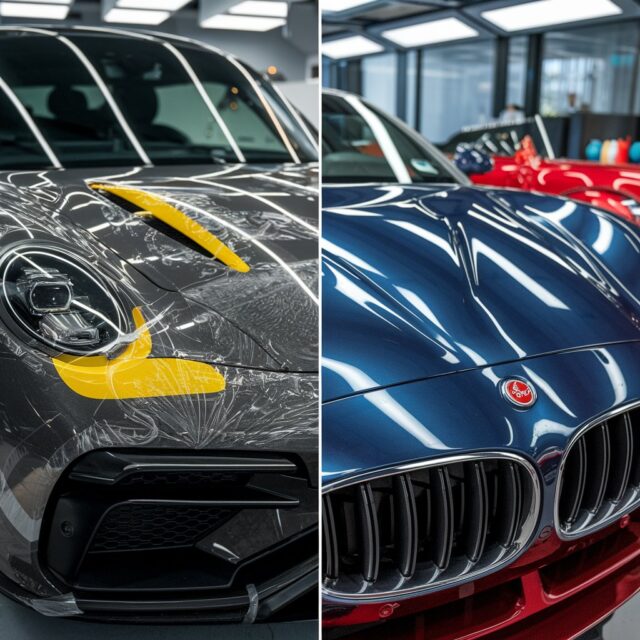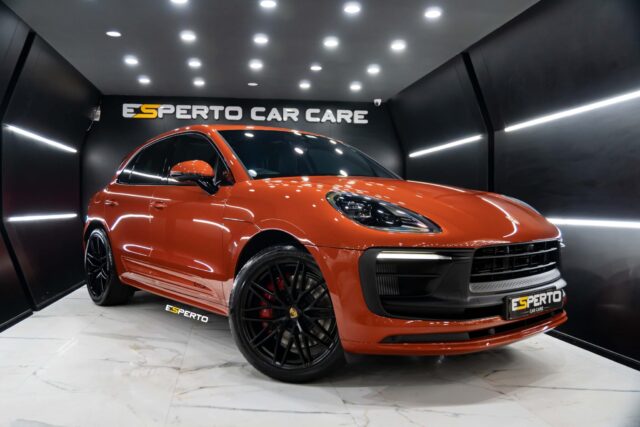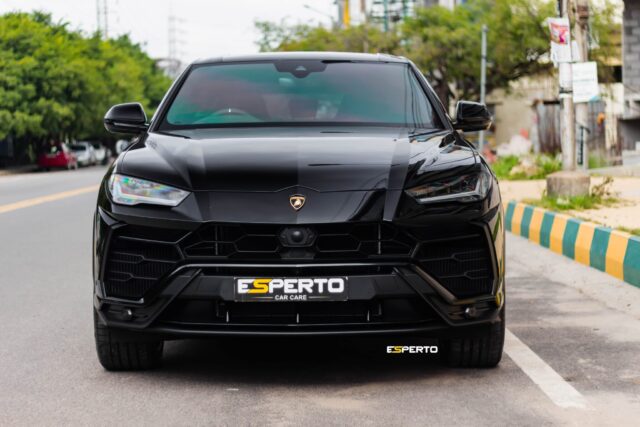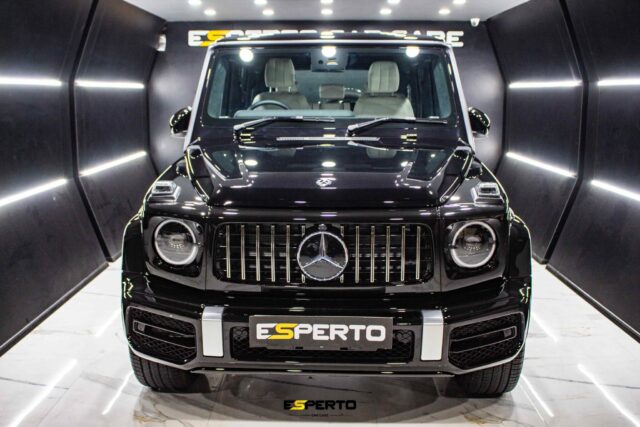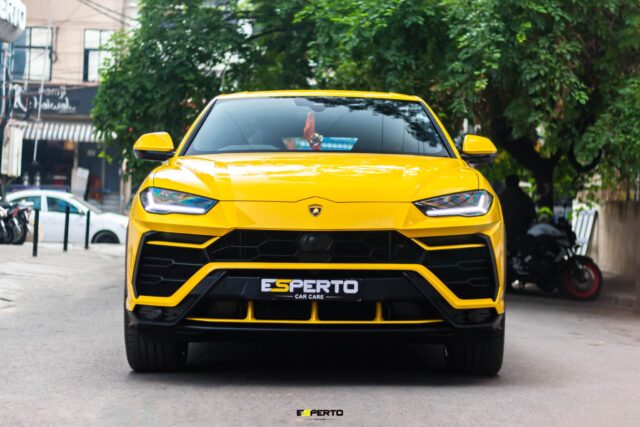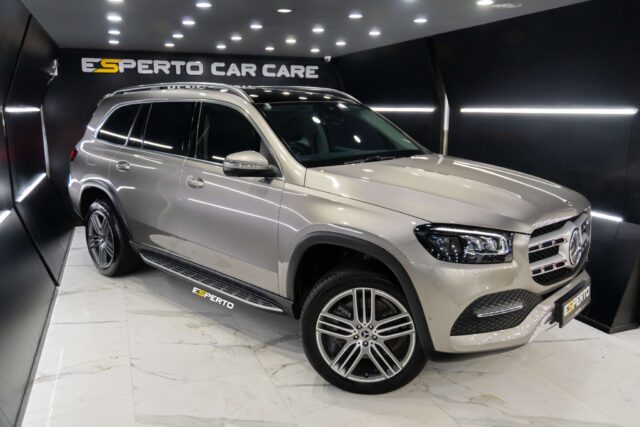PPF vs. Ceramic Coating: Understanding the Differences and Choosing the Best Paint Protection for Your Car
What is Ceramic Coating, and How Does it Work?
Transitioning from the brief overview, let’s also examine the functionality of ceramic coatings. A ceramic coating is a liquid polymer that affixes directly to your automobile’s finish.
This defensive layer links with the paint, establishing a safeguard against all environmental hazards: harm, grime, and ultraviolet rays. This process is carried out with extreme attention to detail, making sure that the entire surface of your vehicle gets thoroughly covered.
The primary benefit of utilizing ceramic coatings is their ability to safeguard your car’s initial paint while also providing a glossy finish. It serves as a defense against a variety of contaminants, such as bird feces, tree sap, and road salts, which might lead to corrosion over prolonged periods.
Furthermore, it simplifies the cleaning process by making it harder for water and dirt to stick, and it helps prevent paint discoloration from sunlight exposure. Ceramic coatings grant long-term protection, eliminating the need for frequent reapplications such as those required with conventional wax solutions.
Understanding Ceramic Coatings
Ceramic coatings help to protect your car’s paint, providing a shield against various types of damage. Formulated from chemicals that bind with the vehicle’s original paint, ceramic coatings similar to coating establishes hard and resistant surface.
This protective layer wards off scratches, UV rays, and chemical stains while ensuring that the paint is easier to clean and maintains its shine for an extended time.
An effective ceramic coating goes beyond maintaining your car’s appearance to also improve its durability.
Different from wax or sealants that provide temporary safeguarding, ceramic coatings offer lasting protection. Their water-repellent properties enable water to bead up and slide off the surface, automatically removing dirt and grime in the process.
This characteristic greatly reduces the frequency of washes and eliminates worries about contaminants from the environment becoming embedded in the paint surface. While the application process does require accuracy, cars receive extra protection against everyday wear and tear and exposure to harsh conditions, once it’s done.
How Ceramic Coatings Protect Your Car’s Paint
Ceramic coatings give exterior surfaces of your car’s paint job a strong layer of protection against various elements. This protective coating forms a hard, durable surface over the factory paint. It guards against scratches, dirt, and water damage.
The ceramic coating makes cleaning your car easier too. Dirt and grime slide off the slick surface without sticking.
The technology behind these ceramic coatings also helps to protect car paint from fading due to sun exposure. UV rays can cause colors to dull over time, but a ceramic coating keeps your car looking vibrant.
It essentially acts as a sunscreen for your vehicle’s exterior, extending the life of the paint job and preserving its shine.

The Benefits of Using Ceramic Coatings
After discussing the protective qualities of ceramic coatings for your car’s paint and plastic trim, let’s explore the advantages of using them as these defensive layers. Ceramic coatings provide a sturdy barrier against various influences, contributing to preserving your car’s fresh look for longer periods.
Differing from standard waxes, ceramic coating connects with the paint on a molecular level, offering a durable finish.
This enhanced protection includes resistance to water, dirt, and UV rays. Cars treated with ceramic coatings become simpler to clean as dirt and grime have less adhesion to the ceramic coat of surface.
Furthermore, this type of coating can significantly boost the gloss and depth of your car’s paint, providing it with a constant “newly-cleaned” look. For automobile owners who want an effective method to conserve their vehicle’s exterior while maintaining its visual charm, thinking about applying a ceramic coating could be the best choice.
Exploring the Concept of Paint Protection Film (PPF)
Paint Protection Film (PPF) is a thermoplastic urethane film applied to a car or bike’s painted surfaces. This technology shields paint from rock chips, scratches, and contaminants like bird droppings and tree sap.
Applying PPF involves thoroughly cleaning the vehicle’s surface before strategically placing the film over areas most prone to damage. The process ensures that every corner fits perfectly, providing the car owner with an invisible layer of protection that maintains the vehicle’s aesthetic appeal.
PPF offers significant advantages, including its ability to self-heal minor scratches when exposed to heat. This feature keeps cars looking newer for longer. Despite these benefits, there are drawbacks to consider; PPF may be more expensive than ceramic coatings and requires professional installation for best results.
Its durability also varies depending on maintenance habits and exposure conditions but typically lasts between five to ten years with proper care.
What is PPF and How is it Applied?
PPF stands for Paint Protection Film. This product is a thermoplastic urethane film that applies over the paint of cars, bikes, and other vehicles to protect them from scratches, chips, and contaminants like bird droppings and tree sap.
Technicians install PPF by laying the film on the car’s surface after careful cleaning and preparation. They use a squeegee to press out bubbles and ensure the film adheres smoothly without wrinkles or creases.
The application process involves precise cutting of the PPF to fit various parts of the vehicle perfectly. Areas like bumpers, hoods, door edges, and mirrors often receive this protective layer because they are more prone to damage.
The unique property of PPF is its self-healing ability; minor scratches disappear when heat is applied. This makes PPF an excellent choice for maintaining a car’s aesthetic appeal while offering potent protection against everyday wear and tear.
PPF Offers a Layer of Protection
Paint Protection Film (PPF) acts as a shield for your car’s exterior, protecting it from scratches, stone and rock chips, and the harsh effects of the sun. Made of thermoplastic urethane, PPF is a thick, transparent layer that mechanics apply over your car’s paint.
This transparent film blends with your vehicle’s design while safeguarding its shiny appearance. It defends against many forms of paint damage that can happen from daily driving or even parked outdoors.
Car owners value this protection as it maintains their vehicle’s resale value by keeping the exterior in top condition.
PPF provides better protection compared to other options because it has self-healing properties. Minor scratches disappear with heat application, making your car look untouched and new longer.
Whether you own a luxury car or a daily commuter bike, applying PPF means less worry about road debris ruining your car’s paint job afterwards. This level of protection offers peace of mind to car enthusiasts who cherish their vehicles’ aesthetics and want to preserve them against everyday wear and tear.
Benefits and Drawbacks of PPF
Shifting focus from the shielding aspects of Paint Protection Film, let’s explore its benefits and hurdles. Paint Protection Film, also known as PPF, provides a barrier against scratches, chips, and other environmental factors that harm like bird droppings and tree sap.
It boasts a self-healing feature where minor scratches vanish with heat exposure, maintaining your car’s pristine condition for an extended period. This innovative technology positions PPF as a leading option for car owners in search of the most effective paint protection film for their automobiles.
On the contrary, the cost of applying PPF can exceed that of other paint protection methods due to its extensive coverage and labor-demanding implementation process. Further, improper care can lead to peeling or yellowing of the PPF edges, particularly in areas subjected to high UV exposure.
Despite these obstacles, many users consider the advantages of PPF to be worth the challenges, ensuring their vehicle’s visual appeal and value retainment over time.
Comparing Ceramic Coating and PPF: Which is Better?
Ceramic coatings and Paint Protection Film (PPF) are two major options for car paint protection. The decision between PPF or ceramic coating depends on your specific requirements for your vehicle.
Ceramic coating provides a resistant layer that protects from chemical spots, oxidation, and sun damage while giving an appealing gloss to your car. Its reputation for long-lasting shine is well-known but it might not handle impacts from stones or scratches as effectively as PPF.
Paint Protection Film, being thicker than ceramic coatings, gives a physical shield that defends against stone and rock chips, scratches, and other abrasive damage. It has self-healing properties that could eliminate swirl marks when exposed to heat.
The lower initial cost, expense of Paint Protection Films can be higher than ceramic coatings due to its comprehensive coverage and the labor involved in its application. Longevity is another factor; both choices provide long-term protection, but PPF typically needs replacement earlier than the ultra-hard 10H ceramic coating.
Each option has its own benefits – ceramic boosts gloss and makes cleaning easier; PPF provides superior protection against impacts.
Understanding these differences aids car owners in making decisions that align with their requirements and tastes.
Cost Considerations: Is PPF More Expensive Than Ceramic?
After exploring the level of protection offered by PPF, paint protection film vs ceramic coating, and ceramic coating, it’s crucial to consider another important factor: cost. Many car owners find themselves weighing the differences in expense between paint protection film (PPF) and ceramic coatings.
Grasping these costs is essential for anyone seeking to protect their vehicle without overspending.
Generally, PPF tends to be more expensive upfront than ceramic coatings. The reasons include the material’s durability and its ability to self-heal minor scratches, making it a premium option for paint protection.
For instance, installing PPF on an entire car can cost significantly more than applying a high-quality ceramic coating over paint protection film on just select areas of the vehicle.
While both options present long-term savings by preserving your car’s aesthetic appeal and resale value, PPF usually demands a larger initial investment. However, considering the extended lifespan and superior damage prevention capabilities of PPF, it could be worth the extra cost for many car enthusiasts.
Durability and Longevity: Ceramic Coating and PPF
Moving from cost considerations, durability and longevity are crucial when choosing between paint protection options. Ceramic coatings provide a hard layer over the paint that can last up to five years or more, depending on the product’s quality.
This coating enhances your car’s resistance against scratches, other chemical damage, contaminants, and oxidation. It offers an advantage over PPF in terms of ease of cleaning and maintenance.
Paint Protection Film (PPF), on the other hand, excels in defending against physical impacts like stone chips and scratches. PPF is significantly thicker than ceramic coatings and can even self-heal minor scratches under heat.
Its lifespan usually ranges around five to seven years but varies based on environmental conditions and care. Both ceramic coating and PPF ensure the long-term preservation of your vehicle’s appearance, proving themselves as valuable investments for car owners looking for the best paint protection film or coating for their vehicles.
Similarities Between PPF and Ceramic Coatings
PPF films and ceramic coatings both serve the same main goal: they protect your car’s paint. Paint Protection Film (PPF) acts as a barrier against scratches, chips, and environmental contaminants.
Ceramic coatings offer a layer of invisible protection that guards against UV rays, dirt, and water. Both options enhance your vehicle’s appearance by keeping the paint in pristine condition for more extended periods.
These two paint protection products are commonly used in various areas of your car. You might apply a ceramic coating or PPF to safeguard vulnerable spots like the hood, bumpers, and side mirrors paint protectors from damage.
This shared purpose makes them popular choices among car owners looking for reliable ways to preserve their vehicle’s look and value.
Choosing between PPF or Ceramic Coating demands consideration of your specific needs and preferences.
How Both Protect Your Car’s Paint
Paint Protection Film (PPF) and ceramic coatings serve as shields for your car’s paint, each with its unique method of preservation. The PPF vs ceramic coating acts like a physical barrier, protecting the surface from scratches, chips, and stains caused by road debris and environmental pollutants.
This film is especially effective against impacts, making it an ideal choice for maintaining the flawless appearance of your vehicle’s exterior.
Ceramic coatings offer protection by creating a chemical bond with the car’s paint, adding a layer of durability that repels water, dirt, and UV rays. Unlike PPF, ceramic coating enhances the glossiness of your vehicle’s finish while also providing easier cleaning capabilities due to its hydrophobic properties.
Together or separately applied, these solutions enable vehicles to withstand various damaging elements while keeping their luster over time.
Both PPF and ceramic coatings lead to preserving your car’s aesthetic appeal by offering unparalleled protective qualities.
Common Uses for Both Coatings
Both PPF and ceramic coatings serve to shield your car’s exterior from various types of damage. Car owners often apply these top protection films and ceramic coatings to protect their vehicles from scratches, chips, and contaminants like bird droppings or tree sap.
Ceramic coating adds a layer of protection against UV rays that can fade paint over time. On the other hand, PPF is more about guarding against physical impacts; it’s highly effective in preventing dents or scuffs from road debris.
Car enthusiasts might use both options on different parts of their vehicle for comprehensive coverage. For instance, applying PPF on high-impact areas such as the hood, front bumper, and side mirrors, while using ceramic coating for an overall shine and added protection against environmental elements across the entire bodywork.
This dual approach ensures the beauty, original shape and integrity of the original paint job and surface are preserved, making maintenance easier and enhancing the vehicle’s resale value.
Deciding what the difference between PPF and ceramic coating is depends on individual needs and how you use your car or bike.
Choosing the Right Protection: PPF or Ceramic Coating?
Deciding between paint protection films or film and ceramic coating for your car involves considering several factors. Paint Protection Film (PPF) shields your vehicle from physical damages like scratches and dings, making it a great choice if you’re worried about rocks or debris on roads.
On the other hand, a ceramic coating provides a protective layer that repels water and dirt, ensuring your car stays cleaner for longer periods. This option is ideal if you’re looking to ease maintenance while giving your car an enhanced gloss.
Factors such as the size of your vehicle play a crucial role in this decision. Larger cars might benefit more from PPF due to their increased exposure to elements, while compact vehicles can enjoy the sleek finish and easy cleaning that comes with ceramic coatings.
Maintenance needs also differ; PPF may require replacement over time, whereas ceramic coatings need regular washing with specific products to maintain their hydrophobic properties.
Keeping these considerations in mind will help car owners choose the right type of protection that meets both their aesthetic preferences and practical requirements for safeguarding their vehicle’s paint job.
Factors to Consider When Choosing Car Paint Protection
Choosing the right paint protection for your car is crucial. It safeguards your vehicle’s appearance and maintains its value over time. Here are factors to consider when determining whether a ceramic coating or PPF (paint protection film) is the best option for your car:
- Evaluate the size of your car. Larger vehicles might benefit more from PPF due to its ability to cover larger areas seamlessly.
- Think about your budget. Generally, ceramic coatings cost less upfront than PPF, but long-term maintenance costs are considered, too.
- Consider how long you plan to keep your car. If you aim to hold onto it for many years, PPF’s durability may be a wise investment.
- Reflect on where you park your vehicle daily. Cars parked outdoors often face more hazards; thus, PPF could offer better protection against physical damage.
- Assess your local environment’s impact on the vehicle’s exterior. Areas with harsh sunlight or salt used on roads in winter can affect the decision between ceramic coatings and PPF.
- Understand the level of maintenance you’re ready to commit to. Ceramic coatings require less upkeep compared to PPF and can be easier for many owners to manage.
- Factor in the aesthetic result you desire from the paint protection application. Ceramic coatings give a lasting shine, while PPF might better retain the original look of the paint.
- Research how each option protects against specific threats like chemical stains, scratches, and UV damage, aligning with what your car faces most frequently.
- Consult experts or other car owners who have either a ceramic coating or a PPF applied on their vehicles for their insights and satisfaction levels over time.
- Lastly, think about resale value and how either option might impact it if you plan on selling your car in the future; some buyers may prefer one type of protection over another.
Expert Recommendations for Car Owners
Experts in car care advise owners to weigh the differences between PPF and ceramic coatings before making a choice. Ceramic coatings give your vehicle a high gloss finish and provide excellent protection against environmental contaminants.
On the other hand, paint protection films (PPF) offer a physical barrier that other paint protectors guard against scratches, chips, and stains from road debris. Both options protect your car’s paint but serve different purposes depending on your needs.
The right protection depends on your specific conditions and how you use your vehicle.
While ceramic coating may seem less expensive upfront than PPF, it requires more frequent reapplication to maintain its protective qualities. PPFs, though initially more costly, can last significantly longer with proper care, making them a worthwhile investment for those looking for durable protection.
Car enthusiasts should consider factors such as durability, cost over time, and the level of protection needed when choosing between these two options. Maintenance is key for both types of coatings to ensure they continue to protect effectively over time.
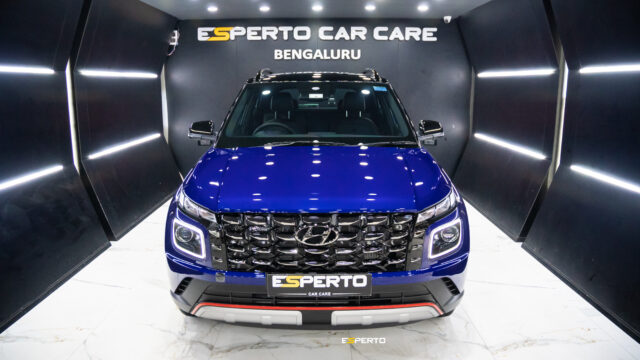
Maintenance and Care for Both Types of Coating
Maintaining your car’s aesthetic appeal is crucial, especially if you’ve invested in paint protection solutions like ceramic coatings or PPF (Paint Protection Film). Proper care extends the life of these coatings, ensuring your vehicle continues to look its best.
Here is a guide on how to maintain and care for both types of coating:
- Wash your vehicle regularly. Use a mild, pH-neutral soap to avoid damaging the coating.
- Avoid automatic car washes. The brushes can be too harsh on the coatings, leading to scratches.
- Apply a specialized hydrophobic top coat every few months to enhance the water-repelling properties of ceramic coatings.
- For ceramic coating maintenance, use a silica-based spray sealant monthly to boost its shine and protective qualities.
- Inspect PPF for any edges that might lift or become damaged over time. Minor repairs can prevent bigger issues.
- Keep your car out of direct sunlight whenever possible. UV exposure can degrade both PPF and ceramic coatings more quickly.
- Promptly remove bird droppings, tree sap, and other contaminants that may damage the coating’s surface.
- Perform a professional annual inspection of the coating to ensure it’s holding up well against damage and wear.
- Avoid using strong solvents and degreasers on both PPF and ceramic-coated surfaces; they can weaken the protective layer.
- After washing, dry your car with a microfiber towel to prevent water spots from forming on either type of coating.
Taking these steps will help protect your investment in paint protection films and ceramic or ceramic coatings. These products compare well with traditional waxing methods alone, offering higher durability and optimal protection against environmental factors that typically damage car paint over time.
Conclusion
Choosing between PPF and ceramic coating depends on your needs. Both offer strong protection for your car but in different ways. Consider how often you use your car and where you drive it.
Look at both options’ costs and durability, too. Your decision will protect your car’s beauty for years.

